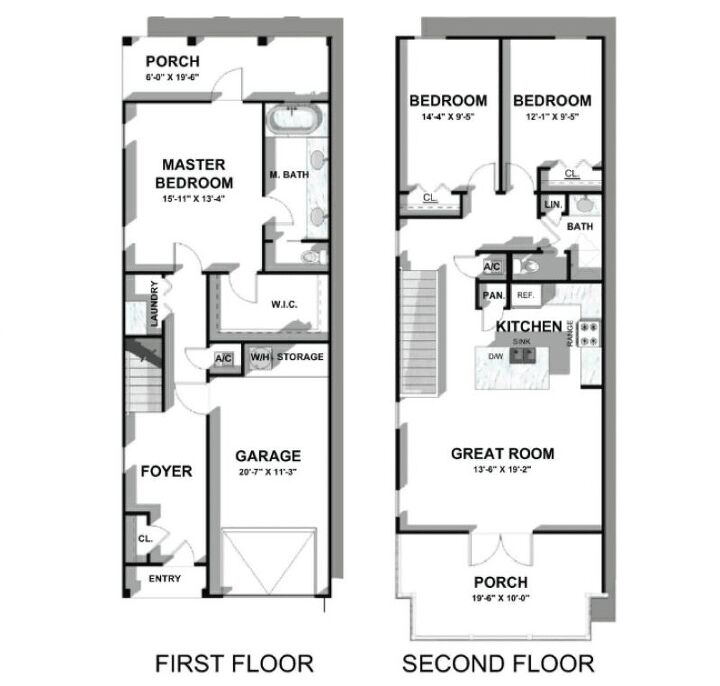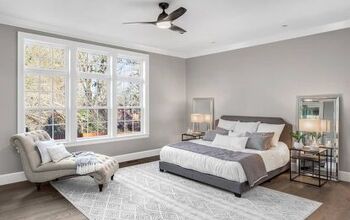Standard Condo Floor Plans (with Drawings)

For some house hunters, maintaining a house and yard is not appealing. Luckily, there are several types of properties to choose from that don’t require much upkeep. One option that also comes at a reasonable price is a condominium, or condo.
The standard size condo is 1,200 square feet. This equates to a 20’x30’ two-story unit. Smaller condos can be 500 square feet, and larger condos can be upward of 5,000 square feet.
What Is a Condo?
A condominium, or condo for short, is a privately-owned individual unit within a community of other units. Condo owners share common areas such as pools, garages, elevators, outside hallways, and gyms. While you find some condos in high-rise buildings, there are also detached condos in some markets.
What Is the Standard Size of a Condo?
The standard-size condominium building contains two single-family dwellings with two stories each. People sometimes identify these types of units as a townhouse. The average size of a single-family condo is 1,200 square feet, approximately 20’x30’ per unit.
What Size Condo Is Right for You?
When hunting for the right condo, it is better to think in terms of household type rather than square feet or rooms. Single people have different needs than couples, and small families have different needs than larger families.
Condo for a Single Person
A smaller condo is best for those who plan to stay single for life or are looking for a starter home. It’s also an excellent option for an investment property.
It’s better to start out smaller than splurge on a huge condo. This can allow you to trade off space for a better location or a more luxurious condo with amenities.
An example of a single-person condo is a shoebox unit which is typically under 500 square feet.
Ideal Condo Size for a Single Person with Hobbies
Some single people look for more space than an initial investment condo, but they don’t need a family-sized condo. A unit between 500 to 750 square feet will be sufficient. This size unit is great for professional photographers, architects, or designers.
Larger one-bedroom condos are big enough to live in comfortably while also setting up an office area or studio. These units are also easier to rent out or sell when you’re ready to move.
The Ideal Condo size for Couples or Small Families
For couples or small families of up to three, consider a two-bedroom condo. These units range from 750 to 1,000 square feet. They make a great first home, give the child and parents privacy, and also provide space for small family gatherings.
Two-bedroom condos are easy to rent; some couples or single people prefer more space, or you can have multiple tenants. Keep in mind, if you want to have multiple children or need more workspace, you may need a bigger condo. Also, note that some two-bedroom condos come with smaller bedrooms or smaller kitchens, which isn’t always suitable for families.
Condo Size for Average Size Families
To live comfortably, a person requires between 200 and 400 square feet of space. So a household of six would require a minimum of 1,200 square feet of space. A household of five could technically get by with 1,000 square feet, but it would likely be a tight fit.
The downside of larger condos like this is that they are more expensive. However, if you don’t mind not living in a central location, you can find some for a great value. Keep in mind that larger units often come with bay windows, A/C ledges, and corridors that increase the price.
Try to choose a unit that has as much usable space as possible.
Luxury Condos
For those who are wealthy and live in large cities like New York, luxury condos are often standard. These high-end units typically include everything you want or need in a home. They are large, spacious, and situated in desirable areas of the city.
When purchasing a luxury condo, expect to pay upwards of $2,000 per square foot. These condos can come in a variety of sizes, some bigger than 5,000 square feet.
Luxury condos are typically in convenient locations, such as near schools, shopping, parks, and transportation. Many also feature top-of-the-line appliances and a host of amenities. Often, amenities include gyms, parking lots, common areas, spas, and even sports complexes.
What Are the Benefits of Purchasing a Condo?
For many buyers, purchasing a condo means simplicity, a smaller price tag, cheaper taxes, and a sense of community.
Less Maintenance
With most condo developments, the only requirement is to take care of the interior of the unit. A professional management company handles any lawn maintenance or exterior upkeep. You typically pay for this maintenance through your HOA fees.
Smaller Price Tag
Historically, condos are more affordable than single-family homes. However, condos also appreciate at a slower pace than single-family homes. For example, condos sold for 17% less in 2020 compared to 2021, with a savings of about $58,000.
Cheaper Taxes
In terms of taxes, condos are often cheaper. A smaller space typically means a smaller tax bill.
Sense of Community
Condos provide a community life that single-family homes don’t often have, such as shared spaces, amenities, and events.
Added Safety and Security
For most who live in condos, it is easier to travel or live seasonally in another area. Condo homeowners get the peace of mind of locking the door and knowing that everything will be taken care of. This is especially true if your condo has a doorman or front desk.
Types of Condos
Living in a condo has become more and more popular, especially to younger generations. However, before purchasing a condo, you should know that there are two major categories, leasehold, and freehold.
Leasehold Condos
The leasehold condo concept enabled institutions unable to sell their land to have options on land utilization and monetization. These institutions include hospitals and universities where the landowner leases the property to the developer for 40 to 99 years. The buyers of the condo don’t own the units, instead, they have leasehold interests.
Freehold Condos
The term freehold means that the condo developer owns the land on which the condo is built. Because the developer owns the land, potential buyers can purchase the condo units. Freehold condos are low-rises, high-rises, and row condos.
Four Types of Freehold Condos
Standard Condos
Standard condos are buildings that consist of separate units alongside common elements. When you purchase a standard condo, you own the unit’s walls, ceiling, and floor. You also own the plumbing, electrical wiring, and sometimes a parking spot.
Any remaining space outside of your unit is known as the common area. You collectively own this space with your neighbors and pay a monthly HOA fee that maintains the area. Examples of common areas are walkways, hallways, driveways, visitor parking, and recreational facilities.
Phased Condos
A phased condo is a standard condo that is developed in phases until the entire project is complete. Phased condos give large-scale developers the chance to sell individual units before the whole building is finished. Condo developers have 10 years to add to the condo and amend the description and declaration of the building.
Vacant Land Condos
At the time of registration, an empty land condo consists of only bare land. Sections of the land are then sold as units of the vacant land condo and built upon. The declarations of the condo outline the regulations and restrictions regarding structures that you can build.
Essentially, the land and the condo together are the unit.
Common Elements Condos
A common elements condo has no units but rather common amenities. They are attached to existing parcels of land (PTOLs). The owners of the land parcels are responsible for maintaining the common elements through cost-sharing.
Other Housing Types and Dimensions
Modular Homes
Modular homes are perfect for empty-nesters looking to downsize or couples looking for backyard units. A modular home is a prefabricated building that consists of repeated sections called modules. Sections are constructed away from the building site, then delivered and completed on-site.
On average, modular homes are about 1,500 square feet and $80 to $160 per square foot. They can cost $120,000 to $270,000 to set up and install.
Single-Family Homes
The average size of a single-family home is 2,531 square feet. They are best for families who prefer a large yard. The average price for a single-family home is $118.91 per square foot.
Multi-Family Homes
Multi-family homes are best for those who are getting into real estate investing. Before purchasing a multi-family home, you should be comfortable with the added responsibility of being a landlord. Also, keep in mind the time and commitment that comes with the job.
To build a multi-family home is usually $64,500 to $86,00 per unit. On average, each unit is 752 square feet. For a multi-family home with four units, expect to pay $258,000 to $336,000 to build.
Bungalow Homes
Bungalow homes range between 1,000 to 2,000 square feet. They are a good option for young families looking for a starter home or retirees looking to downsize. Bungalow homes are also good for single homeowners who want a single-family home without a yard.
On average, bungalow homes cost $187,500, but they can range from $125,500 to $345,000.
Ranch-Style Homes
Ranch-style homes are ideal for those who prefer single-story living. On average, ranch-style homes range from 1,500 to 1,700 square feet.
The national average to build a ranch house is between $196,000 to $625,000. Most people, however, pay around $340,000 for a 1,700 square foot, three-bedroom ranch with a patio and single-car garage.
Related Questions
What makes a condo different from an apartment?
The biggest difference between a condo and an apartment is ownership. An apartment is defined as a residence that is rented, typically part of a larger residential building. A condo is similar in structure to an apartment and within a larger residential building, but someone owns the condo unit.
What is the average cost of condo HOA fees?
Monthly homeowners association fees are typically between $200 to $300. However, the more amenities you have, the more HOA fees will be. Some HOA fees are as little as $100 per month, but others can be more than $3,000 per month.
Related Articles

Stacy Randall is a wife, mother, and freelance writer from NOLA that has always had a love for DIY projects, home organization, and making spaces beautiful. Together with her husband, she has been spending the last several years lovingly renovating her grandparent's former home, making it their own and learning a lot about life along the way.
More by Stacy Randall



























![Standard Dining Room Table Dimensions [for 4, 6, 8, 10 and 12 People]](https://cdn-fastly.upgradedhome.com/media/2023/07/31/9074335/standard-dining-room-table-dimensions-for-4-6-8-10-and-12-people.jpg?size=350x220)




